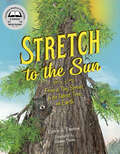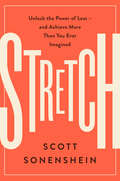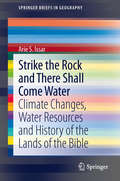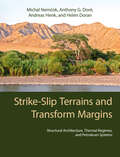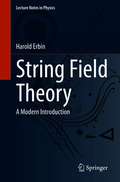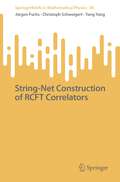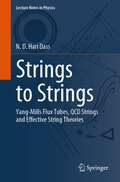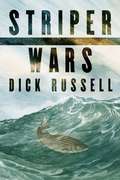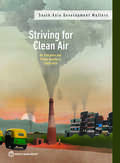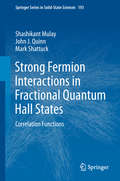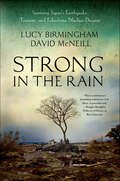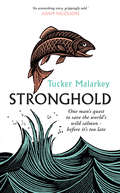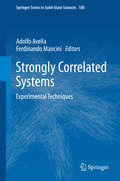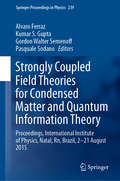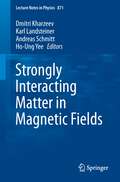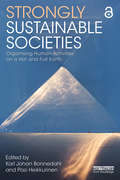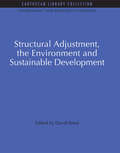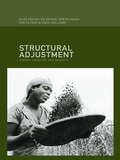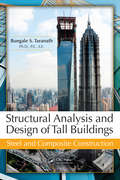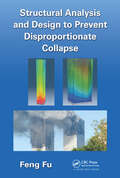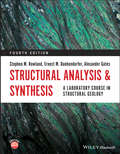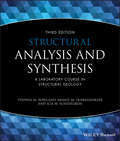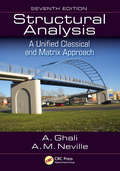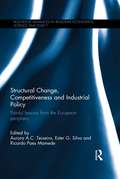- Table View
- List View
Stretch to the Sun: From a Tiny Sprout to the Tallest Tree on Earth
by Carrie A. Pearson"Visually appealing and enjoyable to read aloud, this book is a versatile introduction to redwood trees and forest conservation."—School Library Journal Step into the magical, but true, world of a coast redwood forest -- one of nature's most diverse environments. Experience the life of one tiny tree as it survives despite all odds and grows generation by generation into the tallest tree on earth today. A recipient of a silver Eureka! Award from the California Reading Association for outstanding nonfiction. A children's book about how a once tiny seedling, deep in the forest of Redwood National Park, that was protected by the animals and plants that surrounded it, stretched toward the sun to become the tallest known tree on earth. It survived ecological and human threats and flourished for over 1200 years. Logging in the nineteenth and twentieth centuries depleted the coastal redwood population significantly. But the creation of northern California's Redwood National Park in 1968 helped to save some of the ancient trees, like this one. The tree was discovered by tall tree scientists in 2006, but in the hopes to keep the tree safe, its exact location is kept secret.Susan Swan&’s eye-catching illustrations are made of found objects and hand-painted papers bringing a natural depth and texture to the story. Peppered with impressive facts about trees and extensive backmatter, Pearson proves that every tree has a story to tell.
Stretch: Unlock the Power of Less -and Achieve More Than You Ever Imagined
by Scott SonensheinA groundbreaking approach to succeeding in business and life, using the science of resourcefulness.We often think the key to success and satisfaction is to get more: more money, time, and possessions; bigger budgets, job titles, and teams; and additional resources for our professional and personal goals. It turns out we’re wrong. Using captivating stories to illustrate research in psychology and management, Rice University professor Scott Sonenshein examines why some people and organizations succeed with so little, while others fail with so much.People and organizations approach resources in two different ways: “chasing” and “stretching.” When chasing, we exhaust ourselves in the pursuit of more. When stretching, we embrace the resources we already have. This frees us to find creative and productive ways to solve problems, innovate, and engage our work and lives more fully.Stretch shows why everyone—from executives to entrepreneurs, professionals to parents, athletes to artists—performs better with constraints; why seeking too many resources undermines our work and well-being; and why even those with a lot benefit from making the most out of a little.Drawing from examples in business, education, sports, medicine, and history, Scott Sonenshein advocates a powerful framework of resourcefulness that allows anybody to work and live better.
Strike the Rock and There Shall Come Water
by Arie S. IssarThis book presents an update and revision of the book Water Shall Flow from the Rock - Hydrogeology and Climate in the Lands of the Bible by A. Issar, published by Springer-Verlag in 1990. The enormous quantity and quality of new data added since 1990 called for a thorough update. Another reason for this work is the better understanding achieved since the initial book was published about the role which climate plays in shaping the history of the Lands of the Bible. Albeit the fact that the impact of climate change was touched upon rather widely in the first book, still, without interweaving the new data and understanding, the picture would have remained partial.
Strike-Slip Terrains and Transform Margins: Structural Architecture, Thermal Regimes and Petroleum Systems
by Michal Nemčok Anthony G. Doré Andreas Henk Helen DoranMany of the world's continents are bounded or traversed by vast fault networks that move laterally, like the well-known San Andreas Fault. As well as being major tectonic features of the Earth's surface, these strike-slip regimes are vitally important to the world's natural resources – petroleum, water, and geothermal energy. This book covers all aspects of these regimes; how they initiate; how they develop; and the natural resources associated with them. Numerous global case studies illustrate structural development, thermal and fluid flow implications, and commercial applicability. No other book provides such a comprehensive overview of these settings, and this volume will stand as a critical reference of the state of knowledge of strike-slip terrains and transform margins. It will be invaluable for a broad range of readers, from advanced students of geology and researchers specializing in strike-slip regimes to geoscientists and managers involved in natural resources and energy solutions.
String Field Theory: A Modern Introduction (Lecture Notes in Physics #980)
by Harold ErbinThis textbook provides an introduction to string field theory (SFT). String theory is usually formulated in the worldsheet formalism, which describes a single string (first-quantization). While this approach is intuitive and could be pushed far due to the exceptional properties of two-dimensional theories, it becomes cumbersome for some questions or even fails at a more fundamental level. These motivations have led to the development of SFT, a description of string theory using the field theory formalism (second-quantization). As a field theory, SFT provides a rigorous and constructive formulation of string theory. The main focus of the book is the construction of the closed bosonic SFT. The accent is put on providing the reader with the foundations, conceptual understanding and intuition of what SFT is. After reading this book, the reader is able to study the applications from the literature. The book is organized in two parts. The first part reviews the notions of the worldsheet theory that are necessary to build SFT (worldsheet path integral, CFT and BRST quantization). The second part starts by introducing general concepts of SFT from the BRST quantization. Then, it introduces off-shell string amplitudes before providing a Feynman diagrams interpretation from which the building blocks of SFT are extracted. After constructing the closed SFT, the author outlines the proofs of several important properties such as background independence, unitarity and crossing symmetry. Finally, the generalization to the superstring is also discussed.
String Theory and M-Theory: A Modern Introduction
by Katrin Becker Melanie Becker John H. SchwarzString theory is one of the most exciting and challenging areas of modern theoretical physics. This book guides the reader from the basics of string theory to recent developments. It introduces the basics of perturbative string theory, world-sheet supersymmetry, space-time supersymmetry, conformal field theory and the heterotic string, before describing modern developments, including D-branes, string dualities and M-theory. It then covers string geometry and flux compactifications, applications to cosmology and particle physics, black holes in string theory and M-theory, and the microscopic origin of black-hole entropy. It concludes with Matrix theory, the AdS/CFT duality and its generalizations. This book is ideal for graduate students and researchers in modern string theory, and will make an excellent textbook for a one-year course on string theory. It contains over 120 exercises with solutions, and over 200 homework problems with solutions available on a password protected website for lecturers at www. cambridge. org/9780521860697.
String-Net Construction of RCFT Correlators (SpringerBriefs in Mathematical Physics #45)
by Yang Yang Jürgen Fuchs Christoph SchweigertThis book studies using string-net models to accomplish a direct, purely two-dimensional, approach to correlators of two-dimensional rational conformal field theories. The authors obtain concise geometric expressions for the objects describing bulk and boundary fields in terms of idempotents in the cylinder category of the underlying modular fusion category, comprising more general classes of fields than is standard in the literature. Combining these idempotents with Frobenius graphs on the world sheet yields string nets that form a consistent system of correlators, i.e. a system of invariants under appropriate mapping class groups that are compatible with factorization. The authors extract operator products of field objects from specific correlators; the resulting operator products are natural algebraic expressions that make sense beyond semisimplicity. They also derive an Eckmann-Hilton relation internal to a braided category, thereby demonstrating the utility of string nets for understanding algebra in braided tensor categories. Finally, they introduce the notion of a universal correlator. This systematizes the treatment of situations in which different world sheets have the same correlator and allows for the definition of a more comprehensive mapping class group.
Strings to Strings: Yang-Mills Flux Tubes, QCD Strings and Effective String Theories (Lecture Notes in Physics #1018)
by N. D. Hari DassThis book presents the essentials culminating in the effective string theory of flux tubes in meticulous technical and conceptual detail. The book is divided into four parts. Part One provides historical background, while Part Two (consisting of 14 chapters) covers the passage from Heisenberg's S-matrix theory to String Theory. This includes non-perturbative LSZ formalism, dispersion relations, Regge poles, duality and dual resonance models. Part Three offers a comprehensive analysis of QCD, focusing on important concepts like asymptotic freedom and quark confinement. The section also delves into lattice gauge theories and effective descriptions of superconductivity and strong interactions. Part Four, the final two chapters, describe the lattice gauge theory determinations of Yang-Mills flux tubes in three and four dimensions and effective string theories, including their systematic constructions. These chapters provide detailed technical information to help readers, especially students, develop their expertise in these ideas. This book is ideal for graduate students, postdocs, and senior researchers looking to deepen their understanding of effective string theory and related concepts.
Striper Wars: An American Fish Story
by Dick RussellStriper Wars is Dick Russell's inspiring account of the people and events responsible for the successful preservation of one of America's favorite fish and of what has happened since.
Striving for Clean Air: Air Pollution and Public Health in South Asia (South Asia Development Matters)
by The World BankSouth Asia is home to 9 of the world's 10 cities with the worst air pollution. Concentrations of fine particulate matter (PM2.5) in some of the region's most densely populated and poor areas are up to 20 times higher than what the World Health Organization considers healthy (5 micrograms per cubic meter). This pollution causes an estimated 2 million premature deaths in the region each year and results in significant economic costs. Controlling air pollution is difficult without a better understanding of the activities that cause emissions of particulate matter. Air pollution travels long distances in South Asia and gets trapped in large 'airsheds' that are shaped by climatology and geography. 'Striving for Clean Air' identifies six major airsheds in the region and analyzes four scenarios for reducing air pollution with varying degrees of policy implementation and cooperation among countries. The analysis shows that cooperation between different jurisdictions within an airshed is crucial, and a schematic road map with three phases is proposed. The phases in the road map may overlap when the rate of progress differs, depending on local circumstances. Phase 1 would improve monitoring and institutions; Phase 2 would introduce additional and joint targets for cost-effective abatement; and Phase 3 would mainstream air quality in the economy.
Strong Fermion Interactions in Fractional Quantum Hall States: Correlation Functions (Springer Series In Solid-state Sciences Ser. #193)
by John J. Quinn Shashikant Mulay Mark ShattuckThis monograph presents an intuitive theory of trial wave functions for strongly interacting fermions in fractional quantum Hall states. The correlation functions for the proposed fermion interactions follow a novel algebraic approach that harnesses the classical theory of invariants and semi-invariants of binary forms. This approach can be viewed as a fitting and far-reaching generalization of Laughlin’s approach to trial wave functions. Aesthetically viewed, it illustrates an attractive symbiosis between the theory of invariants and the theory of correlations. Early research into numerical diagonalization computations for small numbers of electrons shows strong agreement with the constructed trial wave functions.The monograph offers researchers and students of condensed matter physics an accessible discussion of this interesting area of research.
Strong in the Rain: Surviving Japan's Earthquake, Tsunami, and Fukushima Nuclear Disaster
by David McNeill Lucy BirminghamA riveting account of Japan's triple disaster and an insightful look into what the responses of its people reveal about the national characterBlending history, science, and gripping storytelling, Strong in the Rain brings the 9.0 magnitude earthquake that struck Japan in 2011 and its immediate aftermath to life through the eyes of the men and women who experienced it. Following the narratives of six individuals, the book traces the shape of a disaster and the heroics it prompted, including that of David Chumreonlert, a Texan with Thai roots, trapped in his school's gymnasium with hundreds of students and teachers as it begins to flood, and Taro Watanabe, who thought nothing of returning to the Fukushima plant to fight the nuclear disaster, despite the effects that he knew would stay with him for the rest of his life. This is a beautifully written and moving account from Lucy Birmingham and David McNeill of how the Japanese experienced one of the worst earthquakes in history and endured its horrific consequences.
Stronghold: One man's quest to save the world's wild salmon - before it's too late
by Tucker MalarkeyStronghold is Tucker Malarkey’s enthralling account of an unlikely visionary, Guido Rahr, and his crusade to protect the world’s last bastion of wild salmon. One of the most determined creatures on earth, salmon have succeeded in returning from the sea to their birth rivers to spawn for hundreds of thousands of years – no matter what the obstacles. But our steady incursions into their habitats mean increasingly few are making it, pushing these fish to near extinction. In this improbable and inspiring story, we follow Guido on a wild and, at times, dangerous adventure from Oregon to Alaska, and then to one of the world’s last remaining wildernesses, in the Russian Far East. Along the way, Guido contends with scientists, conservationists, Russian oligarchs and corrupt officials – and befriends some unexpected allies – in an attempt to secure a stronghold for the endangered salmon, an extraordinary keystone of our ecosystem whose demise would reverberate across the planet. This book is a remarkable work of natural history, a clarion call for a sustainable future and a riveting insight into a fish whose future is closely linked to our own. p.p1 {margin: 0.0px 0.0px 0.0px 0.0px; font: 12.0px 'Adobe Garamond Pro'} p.p2 {margin: 0.0px 0.0px 0.0px 0.0px; font: 12.0px 'Adobe Garamond Pro'; min-height: 14.0px}
Strongly Correlated Systems
by Ferdinando Mancini Adolfo AvellaThis volume presents, for the very first time, an exhaustive collection of those modern numerical methods specifically tailored for the analysis of Strongly Correlated Systems. Many novel materials, with functional properties emerging from macroscopic quantum behaviors at the frontier of modern research in physics, chemistry and material science, belong to this class of systems. Any technique is presented in great detail by its own inventor or by one of the world-wide recognized main contributors. The exposition has a clear pedagogical cut and fully reports on the most relevant case study where the specific technique showed to be very successful in describing and enlightening the puzzling physics of a particular strongly correlated system. The book is intended for advanced graduate students and post-docs in the field as textbook and/or main reference, but also for other researchers in the field who appreciate consulting a single, but comprehensive, source or wishes to get acquainted, in a as painless as possible way, with the working details of a specific technique.
Strongly Coupled Field Theories for Condensed Matter and Quantum Information Theory: Proceedings, International Institute of Physics, Natal, Rn, Brazil, 2–21 August 2015 (Springer Proceedings in Physics #239)
by Alvaro Ferraz Kumar S. Gupta Gordon Walter Semenoff Pasquale SodanoThis book presents a selection of advanced lectures from leading researchers, providing recent theoretical results on strongly coupled quantum field theories. It also analyzes their use for describing new quantum states, which are physically realizable in condensed matter, cold-atomic systems, as well as artificial materials. It particularly focuses on the engineering of these states in quantum devices and novel materials useful for quantum information processing. The book offers graduate students and young researchers in the field of modern condensed matter theory an updated review of the most relevant theoretical methods used in strongly coupled field theory and string theory. It also provides the tools for understanding their relevance in describing the emergence of new quantum states in a variety of physical settings. Specifically, this proceedings book summarizes new and previously unrelated developments in modern condensed matter physics, in particular: the interface of condensed matter theory and quantum information theory; the interface of condensed matter physics and the mathematics emerging from the classification of the topological phases of matter, such as topological insulators and topological superconductors; and the simulation of condensed matter systems with cold atoms in optical lattices.
Strongly Interacting Matter in Magnetic Fields
by Karl Landsteiner Andreas Schmitt Dmitri Kharzeev Ho-Ung YeeThe physics of strongly interacting matter in an external magnetic field is presently emerging as a topic of great cross-disciplinary interest for particle, nuclear, astro- and condensed matter physicists. It is known that strong magnetic fields are created in heavy ion collisions, an insight that has made it possible to study a variety of surprising and intriguing phenomena that emerge from the interplay of quantum anomalies, the topology of non-Abelian gauge fields, and the magnetic field. In particular, the non-trivial topological configurations of the gluon field induce a non-dissipative electric current in the presence of a magnetic field. These phenomena have led to an extended formulation of relativistic hydrodynamics, called chiral magnetohydrodynamics. Hitherto unexpected applications in condensed matter physics include graphene and topological insulators. Other fields of application include astrophysics, where strong magnetic fields exist in magnetars and pulsars. Last but not least, an important new theoretical tool that will be revisited and which made much of the progress surveyed in this book possible is the holographic principle - the correspondence between quantum field theory and gravity in extra dimensions. Edited and authored by the pioneers and leading experts in this newly emerging field, this book offers a valuable resource for a broad community of physicists and graduate students.
Strongly Sustainable Societies: Organising Human Activities on a Hot and Full Earth (Routledge Studies in Sustainability)
by Karl Johan Bonnedahl Pasi HeikkurinenThe response of the international community to the pressing socio-ecological problems has been framed around the concept of ‘sustainable development’. The ecological pressure, however, has continued to rise and mainstream sustainability discourse has proven to be problematic. It contains an instrumental view of the world, a strong focus on technological solutions, and the premise that natural and human-made ‘capitals’ are substitutable. This trajectory, which is referred to as ‘weak sustainability’, reproduces inequalities, denies intrinsic values in nature, and jeopardises the wellbeing of humans as well as other beings. Based on the assumptions of strong sustainability, this edited book presents practical and theoretical alternatives to today’s unsustainable societies. It investigates and advances pathways for humanity that are ecologically realistic, ethically inclusive, and receptive to the task’s magnitude and urgency. The book challenges the traditional anthropocentric ethos and ontology, economic growth-dogma, and programmes of ecological modernisation. It discusses options with examples on different levels of analysis, from the individual to the global, addressing the economic system, key sectors of society, alternative lifestyles, and experiences of local communities. Examining key topics including human–nature relations and wealth and justice, this book will be of great interest to students and scholars of environmental and development studies, ecological economics, environmental governance and policy, sustainable business, and sustainability science.
Structural Adjustment, the Environment and Sustainable Development: Structural Adjustment, The Environment And Sustainable Development (Environmental and Resource Economics Set)
by David ReedThis is a pioneering study which should serve as a model for future research and will to a wide audience' Dharam Ghai, Director United Nations Research Institute for Social Development Structural Adjustment and the Environment (Earthscan, 1992) was the first book to fully examine the effects of 'structural adjustment programmes the economic reform policies required by the World Bank and IMF as part of their lending operations with borrowing countries. To widespread Critical acclaim it exposed the damaging environmental and social effects of structural adjustment policies, and called for a thorough revision of the then-current development policy. This new work; Structural Adjustment, the Environment and sustainable Development is a major step forward in the study of structural adjustment policies. It looks in detail at new research and analysis into their effects, and incorporates recent studies by a wide range of academics and policy-makers, leading experts and institutes. Focusing on nine in-depth case studies, the book examines the complex links between macroeconomic policies, social impacts and environmental outcomes, and takes a forward-looking perspective in outlining the alternatives to current structural adjustment policies. Review quotes for Structural Adjustment and the Environment 'Should be essential reading for all students of development' Third World Planning Review 'Breaks new ground in the debate on structural adjustment generally. and in the environment/development debate' International Affairs 'The most substantial contribution to date to what is undoubtedly an important area' Development and Change David Reed is director of the Macroeconomics for Sustainable Development Programme of WWF International, and editor of Structural Adjustment and the Environment (Earthscan, 1992). Originally published in 1996
Structural Adjustment: Theory, Practice and Impacts
by Giles Mohan Ed Brown Bob Milward Alfred B. Zack-WilliamsStructural Adjustment: Theory, Practice and Impacts examines the problems associated with Structural Adjustment Programmes (SAPs) and reveals the damaging impacts they can have. The book looks at how the debt crisis of the 1970's forced developing countries to seek external help and then reviews what constitutes as a standard adjustment programme, detailing the political, economic, social and environmental impacts of SAPs. The final section draws together theories and political responses and presents a case for alternatives to the programmes.
Structural Analysis and Design of Tall Buildings: Steel and Composite Construction
by Bungale S. TaranathAs software skills rise to the forefront of design concerns, the art of structural conceptualization is often minimized. Structural engineering, however, requires the marriage of artistic and intuitive designs with mathematical accuracy and detail. Computer analysis works to solidify and extend the creative idea or concept that might have started o
Structural Analysis and Design to Prevent Disproportionate Collapse
by Feng FuHard Guidance on Preventing Disproportionate CollapseDisproportionate collapse is a pressing issue in current design practice. Numerous causes are possible - especially forms of extreme loading, such as blast, fire, earthquake, or vehicle collisions. But it is the mechanism and its prevention which are of especial interest and concern.After the Wor
Structural Analysis and Synthesis: A Laboratory Course in Structural Geology
by Ernest M. Duebendorfer Stephen M. Rowland Alexander GatesStructural Analysis and Synthesis is the best-selling laboratory manual of its kind. Specifically designed to support the laboratory work of undergraduates in structural geology courses, the book helps students analyze the various aspects of geological structures, and to combine their analyses into an overarching synthesis. This book is intended for use in the laboratory portion of a first course in structural geology. As is explicit in the title, this book is concerned with both the analysis and synthesis of structural features. In this 4th edition, the focus of this popular manual has been broadened to include a range of new content and features, including: Video content which demonstrates visually how to perform some of the more challenging structural geology techniques An acknowledgement of the increasing importance of environmental applications of structural geology – vital to students who may go on to pursue careers in the environmental sphere An increased emphasis on quantitative techniques, complete with descriptions of computer program applications Contingent with this quantitative emphasis, the book also outlines the limitations of such techniques, helping students to appropriately apply the techniques and evaluate their trustworthiness Structural Analysis and Synthesis, 4th edition is a renowned and widely recognized aid to students in grasping and mastering the techniques required in structural geology, and will find a home wherever the principles and practices of structural geology are taught.
Structural Analysis and Synthesis: A Laboratory Course in Structural Geology
by Ilsa M. Schiefelbein Ernest M. Duebendorfer Stephen M. RowlandThis widely used, highly readable introduction to structural analysis is specifically designed to support the laboratory work of undergraduates in structural geology courses. The new third edition includes: New and amended exercises and redrafted figures to improve clarity A single fold-out map of the Bree Creek Quadrangle – a mythical site used to help students analyze various aspects of the geologic structures exposed within this quadrangle and ultimately to develop a grand synthesis A user-friendly spiral binding ideal for work in the lab or out in the field An Instructor manual CD-ROM for this title is available. Please contact our Higher Education team at HigherEducation@wiley.com for more information.
Structural Analysis: A Unified Classical and Matrix Approach (Seventh Edition)
by Amin Ghali Adam NevilleThis comprehensive textbook combines classical and matrix-based methods of structural analysis and develops them concurrently. It is widely used by civil and structural engineering lecturers and students because of its clear and thorough style and content. The text is used for undergraduate and graduate courses and serves as reference in structural engineering practice. With its six translations, the book is used internationally, independent of codes of practice and regardless of the adopted system of units.
Structural Change, Competitiveness and Industrial Policy: Painful Lessons from the European Periphery (Routledge Advances in Regional Economics, Science and Policy)
by Aurora A.C. Teixeira Ester Silva Ricardo Paes MamedeThe onset of the global crisis has emphasised the persistence of substantial differences in development and social progress within the euro area. The specific case of countries located in the southern periphery region has come to the centre stage, due to the harsh economic conditions that all these countries have experienced in the recent past. In the aftermath of the American subprime credit bubble, these countries’ high indebtedness raised doubts as to their ability to sustain public finances, with the financial crisis developing and gaining momentum due to the fragilities presented in the economy. To varying degrees of severity, all of these economies have since been forced to introduce strong fiscal tightening programmes in order to achieve fiscal consolidation, which have translated into recession and rising unemployment. This book undertakes a comprehensive analysis of the causes of the crisis in southern European countries, showing that the ‘Achilles heel’ of these economies is rooted in the dismal evolution of productivity and in a specialisation pattern excessively based on the so-called ‘traditional’, low, and low-medium tech industries, which yield low margins, declining export shares and, ultimately, withering international competitiveness. Such evidence suggests that the southern European periphery industrial growth model has reached its limits, demanding a multidimensional policy approach capable of overcoming the magnitude and complexity of the present crisis. Without denying the need to adjust public and private balance sheets, it is argued that finding a sustainable path out of the present problems requires addressing the challenges of productivity growth and competitiveness in the long term.
